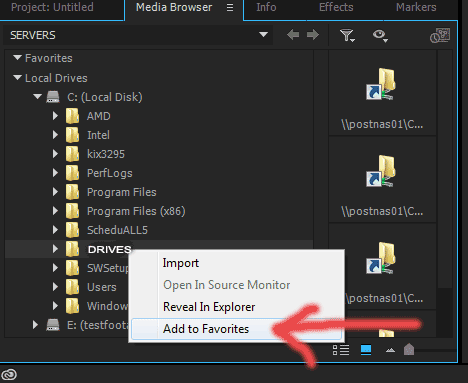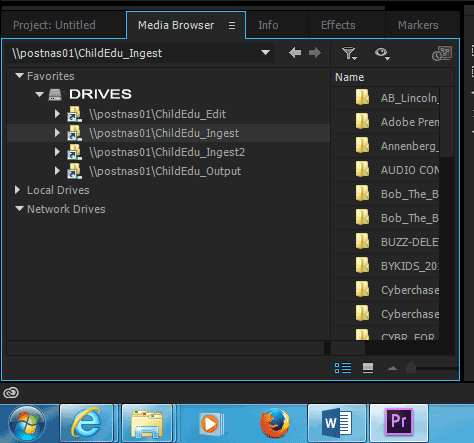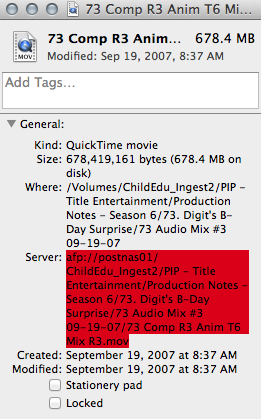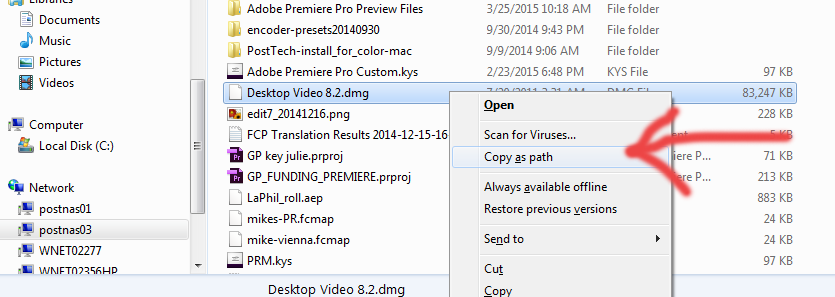Before troubleshooting anything, make sure your WIN or MAC is optimized for video editing by following the Resolve 12 Configuration Guide.
Premiere crashes before opening.
Delete the the file: “Effect Presets and Custom Items.prfpset”, which is stored here:
WIN >C:\Users\<username>\Documents\Adobe\Premiere Pro\9.0\Profile-<username>
MAC>/Users/<username>/Documents/Adobe/Premiere Pro/9.0/Profile-<username>
Video file errors:
“The selected file does not contain video media used by clip references in one or more sequences”
This is a codec not installed or not recognized error. Try opening the file in Quicktime or VLC. If it doesn’t open install the missing codec.
If it opens> Reset Premiere >see step 4 below. Also try trashing Quicktime preferences or un-install/re-install Quicktime.
“The File Has no Audio or Video Streams”
This is another codec error > Quicktime Animation codec is not supported anymore in Premiere 2015
Export ProRes 4444 (Mac only) or Cineform for Mac & PC compatibility.
QuickTime for Windows cannot export H.264 on computers that have more than 16 CPU virtual cores due to a problem in the Apple H.264 compressor component. This means no .MOV from a Windows Machine for ProTools. See Avid-qualified video codecs for Pro Tools 11 and 12
Click here for more Adobe instructions on troubleshooting video files
Adobe Premiere Pro CC has stopped working.

-After the program disappears
-Restart the CPU if you worked more than 3hr.
-Start Premiere by clicking in Start-menu/Dock, NOT the project you had open.
-When the message comes up that the previous project was recovered> save it with a different name in project location.
-Close the recovered project (it is unstable , DO NOT USE!)
-Open the last saved project, either from the Auto Save location or the project folder. (whichever one was the latest)
-Using Media Browser, import the Sequence you where last working on from the recovered project.
-Save the project as, with a new version number>Never rename project files, instead use File >Save as.
-Put the other projects in an “old” folder.
Take care of your project files especially when they get complicated, contain multi-camera sequences, or a lot of media objects (clips, graphics, audio, other media). Managing versions of project files is a necessary part of your job as a video editor. After all, it represents the sum total of all the hours, days, and weeks spent on the project.
Apply these tips in order to prevent time loss:
1. Premiere doesn’t like to be connected to many files in multiple network locations! Improve performance 1000% by working local. Project, Media Caches and Media. That’s what sound mixers and designers do; work local, move final files over network.
Copy the media from the server to a USB-3 SSD (1TB Crucial=$300)
It takes about 1 hour to copy 1TB from the server, easy to relink back to the server.
As a bonus have an SSD as your Media Cache drive. Then you can move around and not have to re-cache the waveform files.
Pay attention to the drive letters. On our systems the first external drive always comes up as (F:) Because the internal media drive is (D:) The DVD is (E:) The second external drive comes up as (H:). So plug them in, in the right order, you can not change the drive letters because you are not administrator.
2. Restart Pr or reboot machine. Adobe has memory leaking out it’s ears. (On PC restart every hour!)
3. If you just imported a file, or added an effect and crashing starts, try to undo or do it different.
4. Trash preferences, to fix all kinds of buggy behavior, like playback stopping after few seconds, or no audio.
Quit Premiere, then re-start in Dock/Start Menu and:
For the Mac, press Shift+Option
For the PC, press Shift+Alt
Verify reset by noticing >recent projects are gone from the splash screen. You’ll have to redo Preferences, Keyboard settings and other things you customized.
5. Only use one creative cloud app at the same time!
Lots of conflicts, stalls and crashes happen because the apps fight over the same GPU, CPU, RAM, output card, media, metadata, preview files etc.
6. Keep the project size under 50MB, >absolute max=70MB (each warp stabilize adds 1 MB to the project size!)
You may want to work in a separate project, render the result out and bring it back into your main project, to speed up project loading and saving. Reduce size by removing: duplicate sequences, warp stabilizes, tracked objects and direct links, then do a save-as.
7. Disconnect any third party hardware, Mouse, Wacom Tablet, external HD, USB-stick etc.
-Remove plug-ins
Temporarily disable everything that runs in background that isn’t absolutely necessary. For example:
-virus checkers
-instant messengers
-skinning software
-power/temperature monitoring software
-automatic updates
-drive monitors/auto-defragmenters.
8. Check that you have more than 20% of free disk space remaining on every hard drive.
9. Stuttery playback:
 -Turn on the Render System Display> Ctrl/CMD+SHIFT+F11
-Turn on the Render System Display> Ctrl/CMD+SHIFT+F11
-Turn on the green dropped frame indicator in the program wrench.
-Try turning off GPU acceleration. (in project settings) If that helps, it’s probably a driver issue. If so, try updating drivers.
–Choppy multi cam playback?> Don’t be in multi cam mode! (you can still live switch using keyboard Ctrl/CMD + 1-0 number keys)
-Click the timeline wrench, and deselect composite preview on trim
–Lower the resolution to 1/2 or 1/4 (The playback and pause resolutions are stored per sequence)
-Put Media Cache Database and Media Cache files on a different drive than startup or media drives, ideally on 2 SSDs working as raid 0. (1000MB/s)
-When cutting native 4k or 5k for delivery at 1080> set your sequence to 1080 and make your previews even smaller like 720p.
-In Sequence Settings > Video Previews, change the codec to one that matches your footage
-Make a new sequence and copy/paste the troubled timeline.
-If you get stutters on rendered green sections >update the GPU driver and check all playback related preferences.
–Check speed and file locations all HDs.
When green sections stutter you know for sure that your hard drives or connections to them are too slow.
Open Activity Monitor or task manager >performance tab >resource monitor. Monitor disk or network speed when the system is working well and compare when it stutters.
10. “Error Compiling Movie” when rendering or exporting.
If your renders and exports are not 1/4 real time or better, you are not using an optimized workflow!
ALWAYS export using the “Match Sequence Settings” checkbox and “Use Previews”
NEVER transcode from timeline to some other format like MP4.
From Adobe’s “Error compiling movie” checklist.
With export/render errors try:
A. Switch renderer to “Software Only” in Project settings.
B. Set the rendering optimization preference to ‘Memory.’
C. Remove Mp3, or any other compressed audio from the timeline, transcode to WAV or AIF and replace.
D. Export WAV. 24bit, 48k audio only, then cut that into the sequence as the only audio track without any master track filters or effects applied.
E. Export via AME and turn preview on. Watch the encoding until it fails. That is the spot on the timeline you need to fix. (corrupt FX or transition?)
F. Try exporting sections to see if you can isolate the issue.
G. With large images, turn on: Preferences>General>Default scale to frame size, BEFORE importing.
This will match the sequence size, improving performance. Limit image size to 5000 pix longest side, or Preferences>Memory>Optimize rendering for>Memory (restart Premiere)
Specific errors:
“File not found.” Make sure all input (source) files are linked. (See Relinking offline media for more information.)
“Disk full” Make room on the hard disk that you’re exporting to, or choose a hard disk with adequate space.
“Duplicate file.” Make sure that the name and destination specified for the output file is unique.
“I/O error.” Make sure the hard disk has adequate room and you have permission to write to the specified output location.
“Unable to save file.” Destination file is in use by Premiere” or “Destination file is in use by Adobe Media Encoder.” An application is using the destination file. For example, the destination file can also be in use as an input file for another operation. If possible, close the program using the file.
“Invalid output drive.” The specified hard disk can’t be written to or found. Choose another output location.
“Out of memory.” To maximize available memory, set the rendering optimization preference to ‘Memory.’
“Unable to create or open output file.” Check that the hard disk has adequate room and you have permission to write to the specified output location. (See Managing the media cache database for more information on freeing up hard disk space by clearing out cached media files.)
“You do not have permission to create or delete the output file.” Choose a destination folder that you have write access to, or change permissions on the destination folder so that Adobe Premiere Pro has write access.
“Codec compression error.” This codec may be unable to support the requested frame size, or there may be a hardware or memory problem.”
Try an unconstrained codec, such as None in an AVI container or ProRes 4444 in a QuickTime container to determine whether the frame size is the issue. (See File formats supported for export for more information.)
“Unknown error.” The specific cause of the error is unknown by Adobe Premiere Pro. The Solutions for unknown errors section can help you identify the problem.
11. Check Preferences>Memory=set to Performance.
Premiere will use up to 16 cores for rendering, but sequences requiring large amounts of memory – like sequences with large stills – will need too much memory and your system will potentially starve on RAM. You can make a struggling system more stable by changing this setting to Memory. Remember to change back to Performance when done.
12. Delete Media Cache Files (by trashing the folder in Explorer/Finder)
13. Clean the Media Cache Database by pressing the Clean button, If that doesn’t work, manually delete the cache files from the media cache folder while Premiere Pro is closed. Then relaunch Pr and allow them to be regenerated.
14. Trash all Preview files (by trashing the folder in Explorer/Finder) and re-render.
15. Update Premiere Pro to the latest version
16. Run the Adobe CC Cleaner Tool to resolve installation issues.
17. Run “NUCLEAR” Scripts from VideoRevealed.com
18. Ensure Adobe preference files are set to read/write
19. Before opening project, Sign out from Creative Cloud, restart Premiere Pro, then sign in
20. Repair permissions.
21. Clean your font cache.
22. Create a new user profile in OSX or WINDOWS with ADMIN privileges and try to run from there.
23.Warp stabilizer in Premiere doesn’t work with interlaced footage > use AE instead.
24. With audio playback problems, make sure the Dolby codecs are installed, by doing an export H264 choosing Dolby as the export format. If they are not loaded they will automatically get loaded.
Premiere in networked environment.
These tips apply only to Premiere standalone systems. Premiere Pro was not designed with a multiple editor workflow in mind. It is meant for one editor, one machine. Building a network based editing system shared by other editors can be a major undertaking. One which requires knowledge of data throughput, data rates, and networking, in general. If any of these things are out of balance, you may experience all kinds of issues. Differentiating Premiere troubleshooting form Network/Drive performance issues is important. For that, I recommend taking Premiere Pro off the network and troubleshoot the system standalone first.
Do not use network drives for Media Cache Database.
If Premiere Pro is trying to use a disk that is no longer accessible, or a directory (folder) that is read-only, it causes strange problems.
Adobe’s FAQ Speeding up rendering & exporting
1. If moving between MAC<>WIN check permissions & file path.
2. Import sequence into new project
3. Match the 7 Scratch Disk and Media Preferences on both systems BEFORE opening project.
4. Right-click on problematic shots that don’t play in the timeline and “Restore Unrendered”
5. Premiere might be unable to access the preview files. Test by setting a new location for preview files (in scratch disks) and re-render.
6. As a last resort, trash all preview files and re-render.
Crashes/errors all the time, system never works right:
Build/Configure a balanced system.
When you drive a Porsche 928 with it’s 800+ HP engine in rush hour. The engine is mostly idle. The Porsche is no faster than the Fiat 500 in the next lane, despite the enormous power of the engine.
The CPU and memory need to feed the video card with data, in order for the video card to do its magic. If the data feed is no more than a trickle, the video card is mostly idle, waiting for the next trickle of data.
A faster CPU and more memory help to increase the trickle to a steady stream of data. That’s just talking about GPU, CPU and RAM, the disk setup has to also be very fast on all volumes with transfer rates in excess of 800 MB/s or 6 Gbps.
Multi core CPU (at least 8), Recommended RAM (at least 5 gigs per core), GPU (at least 4GB ram or 1000+cores),
SSD vs HD as system drive gives about a 3x speed bump in overall performance.
Use at least
10G Ethernet to connect to storage.
In my experience the differences between MAC & WIN have disappeared. It all comes down to configuration, settings, hardware, codec and ultimately workflow. Adobe has gone on record via their
Adobe Hardware Performance Whitepaper to point out that the performance of their software comes down to specs, not operating system. But for some projects (like when PRORES is involved) you want to be on MAC.
PRORES does not work at all on PC!
General Tips:
Work your way through each of your hardware devices and visit the manufacturer’s Web site to download and install the latest drivers.
Video card and audio card drivers are the primary causes of problems, but drivers for other pieces of hardware often cause problems too.
Sometimes it may be better to revert to a previous version of your video or audio driver if the latest version causes problems.
Be aware that
New NVIDIA drivers will no longer support older CUDA GPUs
If you have
AMD GPUs or you are on a
MAC, make sure
CUDA is
not installed. On a
MAC use OpenCL as the renderer.
For certain applications, such as Blackmagic DaVinci Resolve, CUDA drivers are automatically installed, even if you have AMD GPUs. CUDA must be installed in order for that application to launch. If other applications have issues, you may need to install a different version of the CUDA drivers. Currently, if you need to have CUDA software installed on AMD hardware, you can install the 5.5.28 CUDA drivers. In the future,
consult support for the manufacturer for the correct CUDA driver version. If CUDA drivers do not need to be installed, please do not install them. It’s best to not have CUDA drivers on non-CUDA hardware unless you absolutely need to, as in the case with Resolve. Stay away from any Quadro card when purchasing GPUs for Adobe software. Quadros are crazily overpriced and only offer minor performance gains when used with software designed specifically for Quadro drivers of which Adobe software isn’t anyway.
NVIDIA Card with Yosemite and Premiere causing graphics failure MAC ONLY
Excellent
YouTube video about trouble shooting.
ADOBE’s
Troubleshoot system errors and freezes (Windows)
ADOBE’s
Troubleshoot system errors and freezes (Mac OS)
Troubleshooting QuickTime errors with After Effects.
Adobe’s “Error compiling movie” checklist.

![]()
![]()
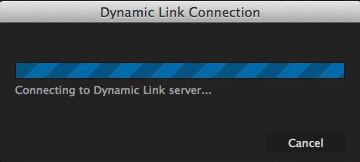 The fastest way to render in any of the Adobe apps is standalone but with a beefy machine you can drag Ae Comps to Adobe Media Encoder for rendering while working.
The fastest way to render in any of the Adobe apps is standalone but with a beefy machine you can drag Ae Comps to Adobe Media Encoder for rendering while working.![]() The best Direct Link in the suite is the “either-or” exchange between Pr and Sg (Speed Grade). This is not a direct link like the others. You add Lumetri effects to clips in the 12-way color corrector in Speed grade, close the project in Sg, open it in Pr and continue editing. This truly saves a lot of time because you can color correct as you go.
The best Direct Link in the suite is the “either-or” exchange between Pr and Sg (Speed Grade). This is not a direct link like the others. You add Lumetri effects to clips in the 12-way color corrector in Speed grade, close the project in Sg, open it in Pr and continue editing. This truly saves a lot of time because you can color correct as you go. If your preview codec matches your media files you can check “Use Previews” which will significantly speed up exports by not having to re-render. It can be a double edged sword though, because when the preview files are a lower quality like “I-frame Only MPEG” then you’ll render lower quality footage into the file.
If your preview codec matches your media files you can check “Use Previews” which will significantly speed up exports by not having to re-render. It can be a double edged sword though, because when the preview files are a lower quality like “I-frame Only MPEG” then you’ll render lower quality footage into the file.


